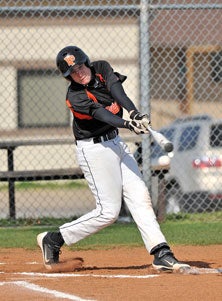
The bunt is making its way back into baseball as changes in metal bat rules have caused managers to rethink strategy.
File photo by Louis Lopez
Eric Kibler has firsthand knowledge of Black Magic. It dates all the way back to the late 1980s when high school baseball was changed forever.
Well, forever might be a little strong.
Let's change that to 2012, when the game that the
Horizon (Scottsdale, Ariz.) baseball coach loves so much made a reappearance.

Hitters like Brett Urabe of HuntingtonBeach (Calif.) will notice that ballsdon't come off bats as fast.
Photo by Terry Jack
"I remember Green Easton and the Black Magic bats in the 1980s and that was a big sweet spot," Kibler said. "It didn't have the trampoline effect (like the more recent bats), but that's when the game started to change. All of a sudden technology took off and it was like golf – you could hit the ball 300 yards and not be very good."
It turned bottom-of-the-order hitters into power hitting 140-pounders if solid contact, and not even in the sweet spot, was made.
New regulations this year have returned the game to those who love small ball by putting the ball in motion with the introduction of BBCOR bats. The new sticks replace the composite metal bats that made third basemen human targets and slick-hitting shortstops into 10-home run guys.
The National Federation of State High School Associations made the ruling to implement safer, less powerful bats.
This rule change is based on research done by the direction of the NCAA, which started using the BBCOR bats last season.
This research found that composite barrel bats, over time, fell out of compliance with the BESR standard. BESR measures the ball exit speed. Specifically, over time, the composite barrel bats were shown to have increased ball exit speed of 10 to 15 mph faster than what is allowed when broken in.
Kibler said the biggest difference can be seen on hard-hit grounders. Ones that used to get through before the infielder could even make a decisive move are now getting eaten up.
"With the (old bats) the ball traveled faster in the first 90 to 100 feet so a lot of balls got through the infield before. Now that ball gets eaten up," Kibler said. "It rewards you for a good swing."
Home runs are still being hit –
Brock Hill of
Woodlawn (Ill.) has seven in 33 at-bats, while
Dylan Cozens of
Chaparral (Scottsdale, Ariz.) has five in the early going – but there are no more cheapies.
"I've hit the fence a couple of times that probably should have been home runs," said Mountain Pointe senior
Joey Curletta, who had 21 home runs last year and none in the Pride's first six games. "I have to barrel the ball up better and get my timing down."
Curletta will get his in time. He had the protection last year of the state's all-time home run king – Kevin Cron, who set the state record for career (60) and season (27) last year – and the killer bat.
Now he is being pitched differently and dealing with the new bat, a really new bat. On Saturday, March 3, Curletta broke a bat – the cap flew off when he hit an outside fastball off the end – that was only two days old.

Bat changes have given someadvantage back to pitchers.
Photo by Kyle Dantzler
Pride coach Brandon Buck likes the new game – putting players in motion, hitting behind runners, etc. – as it challenges him more as a manger and should turn out better all-around players.
"I like it cause it takes (the cheap hits out of it) and now there are one or two guys you have to be careful with," Buck said. "If you can hit 'em, you can still get it. You are going to see a lot more action with stealing, running and hitting, bunting. It's more of a strategy thing and I've enjoyed it."
And, of course, the pitchers feel like they own more of the plate now.
"I am going after hitters more because it is not coming off the bat like it did," Mountain Pointe righthander
Kyle Detwiler said. "It was frustrating (in years past) because you make a good pitch and still get beat, but now it is a more true game."
Kibler said it will eventually force batters to be hitters.
"If you are not very strong and hit that ball it doesn't go like it did before," Kibler said. "If you hit it on the sweet spot it is still going. I like it because it teaches the kids how to hit instead of swing, so there are no cheapies.
"Balls stay in the air more when they are not hit well and just hang there because they don't have the trampoline effect."
That, or the Black Magic just isn't what it used to be.
Jason P. Skoda, a former Arizona Republic and current Ahwatukee Foothill News staff writer, is a 15-year sports writing veteran. Contact him at jskoda1024@aol.com or 480-272-2449.
